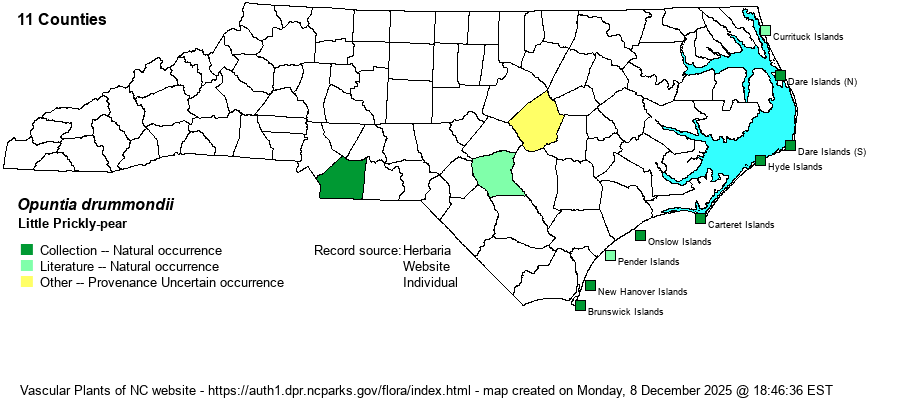| Section 6 » Family Cactaceae |
Show/Hide Synonym
| taxonName | relationship | relatedTaxonName | relatedTaxonRefText | relComments |
|---|
|
| Opuntia drummondii | = | Opuntia pusilla | Flora of North America (1993b, 1997, 2000, 2002a, 2002b, 2003a, 2004b, 2005, 2006a, 2006b, 2006c, 2007a, 2009, 2010) | | | Opuntia drummondii | = | Opuntia pusilla | | | | Opuntia drummondii | = | Opuntia pusilla | | | | Opuntia drummondii | = | Opuntia pusilla | Wunderlin & Hansen Flora of Florida (3) | | | Opuntia drummondii | = | Opuntia pusilla | Barthlott & Hunt in Kubitzki, Rohwer, & Bittrich (1993). | | | Opuntia drummondii | = | Opuntia pusilla | Barthlott & Hunt in Kubitzki, Rohwer, & Bittrich (1993). | | | Opuntia drummondii | = | Opuntia pusilla | apparently mispplied | | | Opuntia drummondii | > | Opuntia drummondii | Small (1933, 1938) | | | Opuntia drummondii | > | Opuntia tracyi | Small (1933, 1938) | | | Opuntia drummondii | > | Opuntia pes-corvi | | | | Opuntia drummondii | > | Opuntia frustulenta | | | | Source: Weakley's Flora |
|
| Author | Graham | |
| Distribution | Almost strictly along the coast, occurring in all coastal counties from Currituck to the SC state line. There were no known records for other counties in the state, until a photo appeared of a population in a powerline clearing in Union County, on iNaturalist, by Gage Sutton in 2023; the population was first discovered in 2022. A specimen is now at the Mecklenburg County Herbarium (fide Becky Dill). There are also good photos on iNaturalist from Cumberland and Johnston counties; the editors for now will consider the first county as a natural site and the second as of uncertain provenance. Because it has been found in several Piedmont counties in SC and west to MS, the editors will consider several of these far inland records as a natural occurrence, for now.
This is a southern species ranging north only to the NC coast, and southward to northern FL and to LA. There are scattered far inland records in NC, SC, GA, AL, and MS.
| |
| Abundance | In barrier beach dunes and sand flats, it can be locally common, but overall along the coast best called infrequent to fairly common. Easily found at Fort Macon State Park in Carteret County. Extremely rare away from the coast. | |
| Habitat | This species is found in low dunes and sand flats back from the beach. The Union County site is a powerline clearing. Outside of NC it can be found on riverine sand bars and around granitic flatrocks. |
| Phenology | This species seldom flowers in NC. If and when it does, it blooms in May and June, and fruits from August to October. | |
| Identification | This cactus is quite different from the widespread O. mesacantha. Though it is also a fleshy, succulent, and prostrate species, with rounded and jointed stems, it is heavily armed with strong 1-inch long spines. The fleshy “pads” are only about 1-inch long on average, but they easily break off when someone steps on them and get the spines stuck in their shoe or (worse) in their foot. As the species seldom flowers, and can be hidden in grasses, one often does not know that he has found this species until he looks at his shoes after walking through dunes or sandy grassy places. Not surprisingly, owing to it seldom flowering and its habitat of easily breaking off of the stem pads, reproduction is typically asexual and new clones of the original parent are thus dispersed by man or other animals. The flowers are yellow and up to 2 inches across, but they seldom can be seen in NC. | |
| Taxonomic Comments | As with the previous cactus species, this “small” species has also been “batted around” from one scientific name to another over the decades. It has typically been named as O. drummondii (RAB 1968) and Weakley (2018), but others have named it as O. pusilla, as does NatureServe.
| |
| Other Common Name(s) | Cockspur Prickly-pear, Dune Prickly-pear, Sand-bur Prickly-pear, Creeping Cactus | |
| State Rank | S3 | |
| Global Rank | G4 | |
| State Status | | |
| US Status | | |
| USACE-agcp | | |
| USACE-emp | | |

